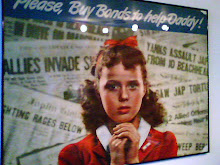How did she keep us amused, unafraid, aware, cautious, even -tempered as she stamped out our freedom? How did she keep herself from drowning in worry? Our summers were being invaded by the polio virus, sweeping the city like a tidal wave. How did she know how to protect us?
My Chicago summers in the early 1940's were explosions of activity. The beach was nearby. Lake Michigan waves were as necessary as air while city temperatures climbed. The Health Department closed the beaches and pools. The streets were our private bicycle paths. We moved around by bicycles, sharing our handlebars. The street vendors were our privae cafes. We feasted on Good Humors, sharing licks. We traveled in crowds, sharing viruses. Our mothers closed down our summer exuberance.
How did she, and all the mothers of kids caught in the path of what came to be the dread disease of summer after summer, killing our freedom, killing and crippling neighbors and friends, survive herself?
We spent the sunny days indoors. Or with our parents on quiet family outings. We were watched carefully for any symptoms that might indicate something other than a summer cold. We heard of classmates rushed to emergency wards of local hospitals. We prayed for them at Sunday masses. We privately prayed we would not be among them. We all knew that our President hd been a victim. Big or small, rich or poor, no one was safe.
The epidemic raged on. Ten years later, having escaped what so many young boys and girls didn't, never having experienced the tragedy that engulfed the families of the stricken children, I was thrust into the midst of the horror. I was now in charge of the Cook Counthy campaign to raise money for polio research, the well-established Mothers' March on Polio. Brand new out of college, brand new on the job, I was sent to meet an iron-clad polio victim being transported into Chicago for rehabilitation. It was a "photo op" to garner publicity for our campaign. I met the train, in from California, and watched as the press photographers positioned themselves around the platform to witness the emergence of the tank surrounding the little body, pumping his lungs, forcing air in and out of them, a mechanical wheezing, keeping him alive.
He was California blonde, a very young boy, tanned, smiling bravely for this Chicago welcome. At first sight, I couldn't contain my sobbing. This is what I had escaped, what my mother had diligently protected me from. I had to leave and return to my office, in disgrace. My boss consoled me, understanding my empathy. "You'll get used to it," implying there would be other iron lungs, more victims, similar assignments. The visual impact of the disease on small children made good copy, raised good money for research. We publicists were using it often and well.
The years of research that the polio foundation had supported paid off -- that year -- with the development of the Salk vaccine, stemming the burgeoning epidemic. Later the Sabin vaccine replaced it and the worry over infantile paralysis, polio, was lifted from parents' shoulders. The success of the vaccines put the Mothers' March out of the polio business. Before I could "get used to it."
Subscribe to:
Post Comments (Atom)

No comments:
Post a Comment